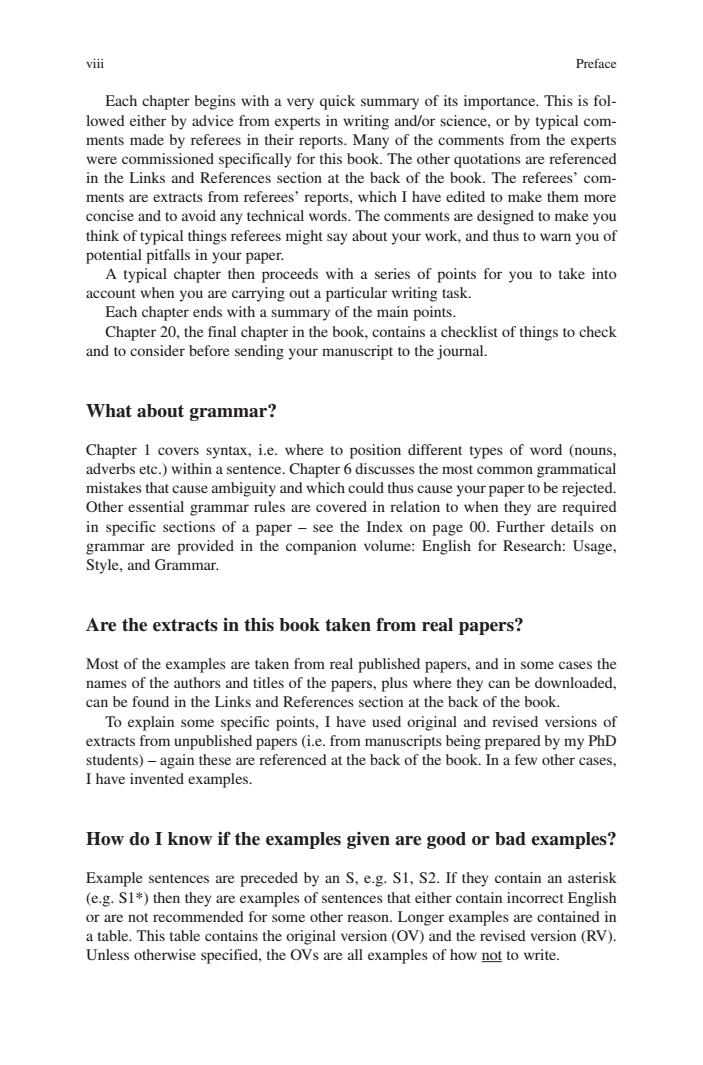正在加载图片...

viii Preface Each chapter begins with a very quick summary of its importance.This is fol- lowed either by advice from experts in writing and/or science,or by typical com- ments made by referees in their reports.Many of the comments from the experts were commissioned specifically for this book.The other quotations are referenced in the Links and References section at the back of the book.The referees'com- ments are extracts from referees'reports,which I have edited to make them more concise and to avoid any technical words.The comments are designed to make you think of typical things referees might say about your work,and thus to warn you of potential pitfalls in your paper. A typical chapter then proceeds with a series of points for you to take into account when you are carrying out a particular writing task. Each chapter ends with a summary of the main points. Chapter 20,the final chapter in the book,contains a checklist of things to check and to consider before sending your manuscript to the journal. What about grammar? Chapter 1 covers syntax,i.e.where to position different types of word(nouns, adverbs etc.)within a sentence.Chapter 6 discusses the most common grammatical mistakes that cause ambiguity and which could thus cause your paper to be rejected. Other essential grammar rules are covered in relation to when they are required in specific sections of a paper-see the Index on page 00.Further details on grammar are provided in the companion volume:English for Research:Usage, Style,and Grammar. Are the extracts in this book taken from real papers? Most of the examples are taken from real published papers,and in some cases the names of the authors and titles of the papers,plus where they can be downloaded, can be found in the Links and References section at the back of the book. To explain some specific points,I have used original and revised versions of extracts from unpublished papers(i.e.from manuscripts being prepared by my PhD students)-again these are referenced at the back of the book.In a few other cases, I have invented examples. How do I know if the examples given are good or bad examples? Example sentences are preceded by an S,e.g.S1,S2.If they contain an asterisk (e.g.S1*)then they are examples of sentences that either contain incorrect English or are not recommended for some other reason.Longer examples are contained in a table.This table contains the original version (OV)and the revised version(RV). Unless otherwise specified,the OVs are all examples of how not to write.viii Preface Each chapter begins with a very quick summary of its importance. This is followed either by advice from experts in writing and/or science, or by typical comments made by referees in their reports. Many of the comments from the experts were commissioned specifically for this book. The other quotations are referenced in the Links and References section at the back of the book. The referees’ comments are extracts from referees’ reports, which I have edited to make them more concise and to avoid any technical words. The comments are designed to make you think of typical things referees might say about your work, and thus to warn you of potential pitfalls in your paper. A typical chapter then proceeds with a series of points for you to take into account when you are carrying out a particular writing task. Each chapter ends with a summary of the main points. Chapter 20, the final chapter in the book, contains a checklist of things to check and to consider before sending your manuscript to the journal. What about grammar? Chapter 1 covers syntax, i.e. where to position different types of word (nouns, adverbs etc.) within a sentence. Chapter 6 discusses the most common grammatical mistakes that cause ambiguity and which could thus cause your paper to be rejected. Other essential grammar rules are covered in relation to when they are required in specific sections of a paper – see the Index on page 00. Further details on grammar are provided in the companion volume: English for Research: Usage, Style, and Grammar. Are the extracts in this book taken from real papers? Most of the examples are taken from real published papers, and in some cases the names of the authors and titles of the papers, plus where they can be downloaded, can be found in the Links and References section at the back of the book. To explain some specific points, I have used original and revised versions of extracts from unpublished papers (i.e. from manuscripts being prepared by my PhD students) – again these are referenced at the back of the book. In a few other cases, I have invented examples. How do I know if the examples given are good or bad examples? Example sentences are preceded by an S, e.g. S1, S2. If they contain an asterisk (e.g. S1*) then they are examples of sentences that either contain incorrect English or are not recommended for some other reason. Longer examples are contained in a table. This table contains the original version (OV) and the revised version (RV). Unless otherwise specified, the OVs are all examples of how not to write